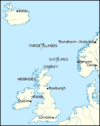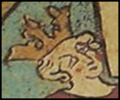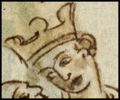Haraldr Guðrøðarson facts for kids
Quick facts for kids Haraldr Guðrøðarson |
|
|---|---|
| King of the Isles | |
| Reign | 1249–1250 |
| Predecessor | Rǫgnvaldr Óláfsson |
| Successor | Magnús Óláfsson |
| House | Crovan dynasty |
| Father | Guðrøðr Rǫgnvaldsson |
Haraldr Guðrøðarson was a king who ruled the Isles in the mid-1200s. He belonged to the Crovan dynasty, a powerful family of "sea-kings." These kings controlled an island kingdom. It included the Isle of Man and parts of the Hebrides islands.
Haraldr's family had a long history of fighting for control. His grandfather, Rǫgnvaldr Guðrøðarson, and his great-uncle, Óláfr Guðrøðarson, battled for the throne. This family feud continued through their children. In 1249, Haraldr Guðrøðarson took the throne after the previous king, Rǫgnvaldr Óláfsson, was killed.
At first, Henry III, King of England recognized Haraldr as the rightful king. However, Hákon Hákonarson, King of Norway was not happy. He summoned Haraldr to Norway for taking the kingdom without permission. Haraldr never returned to the Isle of Man. After he left, another family member, Magnús Óláfsson, eventually became king. He was the last of the Crovan dynasty's sea-kings.
Contents
The Crovan Dynasty: A Royal Family's Story
Haraldr Guðrøðarson was part of the Crovan dynasty. This family ruled the Isle of Man and parts of the Hebrides from the late 1000s to the mid-1200s. They were known as "sea-kings" because their power came from controlling the seas and islands. Haraldr was the son of Guðrøðr Rǫgnvaldsson. His grandfather was Rǫgnvaldr Guðrøðarson, King of the Isles.
While early Crovan kings might have been quite independent, later ones had to pay tribute to the powerful Hákon Hákonarson, King of Norway. This meant they recognized Norway as their overlord.
Family Feuds and Royal Succession
Haraldr's grandfather, Rǫgnvaldr Guðrøðarson, and his younger half-brother, Óláfr Guðrøðarson, fought for control of the kingdom. Rǫgnvaldr was killed in a battle against Óláfr in 1229. After this, Óláfr became king.
In 1231, Rǫgnvaldr's son, Guðrøðr Rǫgnvaldsson (Haraldr's father), tried to claim the throne. For a short time, he shared power with Óláfr. But Guðrøðr Rǫgnvaldsson was killed later that same year. Óláfr then ruled the entire kingdom peacefully until he died in 1237.
Óláfr was followed by his son, Haraldr Óláfsson. This Haraldr traveled to Norway and married King Hákon's daughter. Sadly, he died at sea on his way back home in 1248. In May 1249, Haraldr Óláfsson's brother, Rǫgnvaldr Óláfsson, officially became the new king.
| Simplified family tree of the Crovan dynasty. It shows the kings who came from Guðrøðr Óláfsson, Haraldr Guðrøðarson's great-grandfather. | ||||||||||||||||||||||||||||||||||||||||||||||||||||||||||||||||||||||||||||||||||||||||||||||||||||||||||||||||||||||||||||||||||||||||||||||||||||||||||||||||||||||||||||||||||||||||||||||||||||||||||||||||||||||||||||||||||||||
|---|---|---|---|---|---|---|---|---|---|---|---|---|---|---|---|---|---|---|---|---|---|---|---|---|---|---|---|---|---|---|---|---|---|---|---|---|---|---|---|---|---|---|---|---|---|---|---|---|---|---|---|---|---|---|---|---|---|---|---|---|---|---|---|---|---|---|---|---|---|---|---|---|---|---|---|---|---|---|---|---|---|---|---|---|---|---|---|---|---|---|---|---|---|---|---|---|---|---|---|---|---|---|---|---|---|---|---|---|---|---|---|---|---|---|---|---|---|---|---|---|---|---|---|---|---|---|---|---|---|---|---|---|---|---|---|---|---|---|---|---|---|---|---|---|---|---|---|---|---|---|---|---|---|---|---|---|---|---|---|---|---|---|---|---|---|---|---|---|---|---|---|---|---|---|---|---|---|---|---|---|---|---|---|---|---|---|---|---|---|---|---|---|---|---|---|---|---|---|---|---|---|---|---|---|---|---|---|---|---|---|---|---|---|---|---|---|---|---|---|---|---|---|---|---|---|---|---|---|---|---|
|
||||||||||||||||||||||||||||||||||||||||||||||||||||||||||||||||||||||||||||||||||||||||||||||||||||||||||||||||||||||||||||||||||||||||||||||||||||||||||||||||||||||||||||||||||||||||||||||||||||||||||||||||||||||||||||||||||||||
How Haraldr Guðrøðarson Became King
The Chronicle of Mann, a historical record from the 1200s, tells us what happened next. On May 30, 1249, King Rǫgnvaldr Óláfsson was killed. This happened in a field near the Church of the Holy Trinity at Rushen. He was later buried at the Church of St Mary. The chronicle says a knight named Ívarr and his followers were responsible.
Right after Rǫgnvaldr's death, Haraldr Guðrøðarson appears in the chronicle for the first time. It says he immediately took control of the kingdom. This suggests that Haraldr and Ívarr were working together. A letter from Henry III, King of England in 1256 also supports this idea. It warns Henry's men not to help Haraldr and Ívarr, who "wickedly slew" Rǫgnvaldr.
After taking over, Haraldr Guðrøðarson made big changes. The chronicle says he removed all the old chiefs and nobles who had supported the previous king, Haraldr Óláfsson. He then replaced them with his own followers, many of whom had been exiled before.
The Chronicle of Mann sometimes shows a bias against Haraldr Guðrøðarson's family line. For example, it tells a story about a miracle involving St Mary. This story might have been added to make Haraldr's rule look bad. The story is about an old chief named Domnall, who was a close friend of Haraldr Óláfsson. Domnall and his son had to hide in the Church of St Mary at Rushen from Haraldr Guðrøðarson. The chronicle claims Haraldr tricked them out of the church and captured them. The story says Domnall prayed to St Mary, and she helped him and his son escape. This tale was likely used to make Haraldr Guðrøðarson seem untrustworthy.
Haraldr Guðrøðarson tried to make his rule stronger by talking with King Henry III of England. For a while, Henry did see Haraldr as the rightful king. Henry even gave Haraldr a special pass to travel to the English court between late 1249 and late 1250. This showed that Henry recognized Haraldr's kingship.
Haraldr's Forced Exile
Haraldr Guðrøðarson's time as king was short. In 1250, the chronicle says he was called to the Norwegian royal court. King Hákon of Norway was upset because Haraldr had wrongfully taken the kingship. Hákon did not want Haraldr to return to the Isle of Man. So, Haraldr was kept from going back. We don't hear anything more about him after this.

In the same year, Magnús Óláfsson (another son of Óláfr) and Eóghan arrived on the Isle of Man with Norwegian soldiers. They landed at Ronaldsway and tried to talk with the Manx people. However, when the Manx learned that Eóghan called himself "King of the Isles," they were offended and stopped talking.
Eóghan's men gathered on St Michael's Isle, which is connected to the Isle of Man by a causeway that appears at low tide. The Manxmen gathered on the mainland beach. As the tide went out, Eóghan and some of his men got on their ships. But many of his soldiers stayed on the island. That evening, an ally of Ívarr led an attack on the island. They defeated Eóghan's forces there. The next day, the invading forces left the Isle of Man.
The fact that Ívarr's ally helped the Manx attack suggests that some people on the Isle of Man still supported Haraldr Guðrøðarson. They probably didn't want Magnús to become king. Two years later, Magnús returned to the Isle of Man. This time, the Manx people agreed, and he began his reign.
Even so, some opposition to Magnús likely continued into the mid-1250s. King Hákon officially gave Magnús the title of king in 1254. When Magnús's opponents heard this, their hopes of overthrowing him faded. Henry III's 1256 letter, which warned against helping Haraldr Guðrøðarson and Ívarr, might mean they were still alive and active then. However, Magnús ruled unchallenged as King of Mann and the Isles until he died in 1265. He was the last reigning king of the Crovan dynasty.






